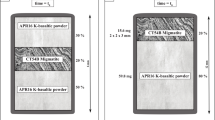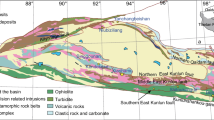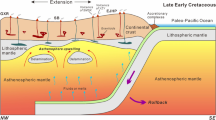Abstract
The Nevado Sabancaya in southern Peru has exhibited a persistent eruptive activity over eight years following a violent eruption in May–June 1990. The explosive activity consisted of alternated vulcanian and phreatomagmatic events, followed by declining phreatic activity since late 1997. The mean production rate of magma has remained low (106–107 m3 per year).
The 1990–1998 eruptive episode produced andesitic and dacitic magmas. The juvenile tephra span a narrow range of compositions (60–64 wt% SiO2). While SiO2 contents do vary slightly, they do not show any systematic variation with time. Phenocryst assemblages in the juvenile rocks consist of mainly plagioclase, associated with high-Ca pyroxene, hornblende, biotite, and iron-titanium oxides. Rare fine-grained magmatic enclaves, with angular to subrounded shapes, are contained within some of the juvenile lava blocks, which were expelled since 1992. They have a homogeneous andesitic composition (57 wt% SiO2) and show randomly oriented interlocking columnar or acicular crystals (plagioclase and amphibole), with interstitial glass and a few voids, which define a quench-textured groundmass.
Textural, mineralogical and chemical evidence suggests that the 1990–1998 eruptions have mainly erupted hybrid andesites, except for the 1990 dacite. The hybrid andesites contain a mixed population of plagioclase phenocrysts: Ca-rich clear plagioclase (An40–60), Na-rich clear plagioclase (An25–35), and inversely zoned “dusty-rimmed” plagioclase with a sodic core (An25–40) surrounded by a Ca-rich mantle (An45–65). Melt-inclusions, wavy dissolution surfaces and stepped zoning within the “dusty-rimmed” plagioclases are compatible with resorption induced by magma recharge events. Chemical and isotopic lines of evidence also show that andesites are hybrids resulting from magma mixing processes. Repeated magma recharge, incomplete homogenisation and different degrees of crustal assimilation may explain the extended range of isotopic signatures.
Our study leads to propose an evolution model for the magmatic system at Nevado Sabancaya. The main magma body consisted of dacitic magmas differentiating through extensive open-system crystallization (AFC). Repeated recharge of more mafic magmas induced magma mixing, leading to the formation of hybrid andesites. A partially crystalline boundary layer formed at the interface between the andesites and the recharge magma. The magmatic enclaves were produced by the disruption and dispersion of this andesitic layer as a result of new magma injection and/or sustained tectonic activity.
Periodic magma recharge and interactions with groundwater are two processes that have enabled the explosive regime to remain persistent over an 8-year-long period. What precise mechanism triggers the eruptive activity remains speculative, but it may be related either to new magma injection, or to the sustained tectonic activity that occurred at that time in the vicinity of the volcano, or a combination of both.










Similar content being viewed by others
References
Allègre CJ, Provost A, Jaupart C (1981) Oscillatory zoning: a pathological case of crystal growth. Nature 294:223–228
Anderson AT (1984) Probable relations between plagioclase zoning and magma dynamics, Fuego volcano, Guatemala. Am Mineral 68:125–129
Antayhua Y (2001) Analisis de la actividad sismica en la region del volcan Sabancaya y de los sismos de Maca (1991), Sepina (1992) y Cabanaconde (1998). Tesis de Licenciatura, Universidad nacional de San Agustin Arequipa, Peru, unpublished, 120 pp
Antayhua Y, Tavera H, Bernal I (2001) Analisis de la actividad sismica en la region del volcán Sabancaya (Arequipa). Bol Soc Geol Perú 92:79–88
Bacon CR (1986) Magmatic inclusions in silicic and intermediate volcanic rocks. J. Geophys Res 91(B6):6,091–6,112
Bacon CR, Hirshmann MM (1988) Mg/Mn partitioning as a test for equilibrium between coexisting Fe-Ti oxides. Am Mineral 73:57–61
Barbarin B (1988) Field evidence for successive mixing and mingling between the Piolard diorite and the Saint-Julien-la-Vêtre monzogranite (Nord Forez, Massif central, France). Can J Earth Sci 25:49–59
Barbarin B (1990) Plagioclase xenocrysts and mafic magmatic enclaves in some granitoids of the Sierra Nevada batholith, California. J Geophys Res 95(B11):17,747–17,756
Barbarin B, Didier J (1991) Macroscopic features of mafic microgranular enclaves. In: Didier J and Barbarin B (eds) Enclaves and granites. Developments in Petrology 13, Elsevier, Amsterdam Oxford New York Tokyo, pp 253–262
Buckley VJE, Sparks RSJ, Wood BJ (2002) Petrology of hornblende decompression reaction textures in the recent Soufrière Hills Volcano andesitic magma. IAVCEI meeting on explosive volcanism in subduction zones: Mount Pelée 1902–2002, abstract, pp 56
Clayton RN, Mayeda TK (1963) The use of bromine pentafluoride in the extraction of oxygen from oxides and silicates for isotopic analysis. Geochim Cosmochim Acta 27:43–52
Clynne MA (1999) A complex magma mixing origin for rocks erupted in 1915, Lassen Peak, California. J Petrol 40:105–132
Coombs ML, Eichelberger JC, Rutherford M.J (2003) Experimental and textural constraints on mafic enclave formation in volcanic rocks. J Volcanol Geotherm Res 119:125–144
Coplen TK (1993) Normalization of oxygen and hydrogen isotope data. Chem Geol 72:293–297
Davidson JP, Tepley FJ (1997) Recharge in volcanic systems: evidence from isotope profiles of phenocrysts. Science 275:826–829
Davidson JP, De Silva SL, Holden P, Halliday AN (1990) Small-scale disequilibrium in a magmatic inclusion and its more silicic host. J Geophys Res 95:17,661–17,675
Delacour A, Paquereau P, Gerbe MC, Thouret JC, Wörner G (2002) Quaternary minor volcanic centres in southern Peru: volcanology, petrology and geochemistry. 5th International Symposium on Andean Geodynamics, Toulouse, France, abstract
De Silva SL, Francis PW (1990) Potentially active volcanoes of Peru: observations using Landsat Thematic Mapper and Space Shuttle imagery. Bull Volcanol 52(4):286–301
De Silva SL, Francis PW (1991) Volcanoes of the Central Andes. Springer, Berlin Heidelberg New York, p 216
Didier J, Barbarin B (1991) The different types of enclaves in granites — Nomenclature. In: Didier J and Barbarin B (eds) Enclaves and granites. Developments in Petrology 13, Elsevier, Amsterdam Oxford New York Tokyo, pp 19–23
Eichelberger JC (1980) Vesiculation of mafic magma during replenishment of silicic magma reservoirs. Nature 288:446–450
Gill JB (1981) Orogenic andesites and plate tectonics. Springer, Berlin Heidelberg New York, pp 1–390
Ginibre C, Kronz A, Wörner G (2002) High-resolution quantitative imaging of plagioclase composition using accumulated backscattered electron images: new constraints on oscillatory zoning. Contrib Mineral Petrol 142:436–448
Global Volcanism Network bulletin (1988) Sabancaya volcano, 13(6):10–12
Global Volcanism Network bulletin (1990) Sabancaya volcano, 15(5):2–4
Global Volcanism Network bulletin (1990) Sabancaya volcano, 15(6):2
Global Volcanism Network bulletin (1990) Sabancaya volcano, 15(7):2
Global Volcanism Network bulletin (1991) Sabancaya volcano, 16 (5):16–17
Global Volcanism Network bulletin (1991) Sabancaya volcano, 16(7):5–6
Global Volcanism Network bulletin (1991) Earthquakes, 16(7):22
Global Volcanism Network bulletin (1992) Sabancaya volcano, 17(1):8–9
Global Volcanism Network bulletin (1994) Sabancaya volcano, 19(3):8–9
Global Volcanism Network bulletin (1995) Sabancaya volcano, 20(5):4
Global Volcanism Network bulletin (1997) Sabancaya volcano, 22(7):14–15
Global Volcanism Network bulletin (1998) Sabancaya volcano, 23(8):4–5
Global Volcanism Network bulletin (2000) Sabancaya volcano, 25 (5):4
Hammarstrom JM, Zen E (1986) Aluminium in hornblende: an empirical igneous geobarometer. Am Mineralogist 71:1,297–1,313
Harmon RS, Hoefs J (1984) Oxygen isotope ratios in late Cenozoic Andean volcanics. In: Harmon RS, Barreiro BA (eds) Andean magmatism chemical and isotopic constraints, Shiva, pp 9–20
Hildreth W, Moorbath S (1988) Crustal contributions to arc magmatism in the Andes of central Chile. Contrib Mineral Petrol 98:455–489
Hollister LS, Grissom GC, Peters EK, Stowell HH, Sisson VB (1987) Confirmation of the empirical correlations of Al in hornblende with pressure of solidification of calc-alkaline plutons. Am Mineral 72:231–239
Huaman-Rodrigo D, Chorowicz J, Deffontaines B, Guillande R, Rudant JP (1993) Cadre structural et risques géologiques étudiés à l’aide de l’imagerie spatiale: la région du Colca (Andes du sud Pérou). Bull Soc géol France 164(6):807–818
James DE (1984) Quantitative models for crustal contamination in the central and northern Andes. In: Harmon RS, Barreiro BA (eds) Andean magmatism chemical and isotopic constraints, Shiva, pp 124–138
Johnson MC, Rutherford MJ (1989) Experimental calibration of aluminium-in-hornblende geobarometer with application to Long Valley caldera (California) volcanic rocks. Geology 17:837–841
Juvigné E, Thouret J-C, Gilot E, Leclercq L, Gourgaud A (1998) L’activité du volcan Nevado Sabancaya (Pérou) au cours de l’Holocene. Quaternary 9(1):45–51
Kanokea I, Guevara C (1984) K-Ar age determinations of late Tertiary and Quaternary volcanic rocks, Southern Peru. Geochemical Journal 18:233–239
Kink BA, Ellison RA, Hawkins MP (1986) The geology of the Cordillera occidental and Altiplano West of lake Titicaca, southern Peru. British Geol Surv Open-File Report 353 pp
Koyaguchi T (1986) Textural and compositional evidence for magma mixing and its mechanism, Abu volcano group, southwestern Japan. Contrib Mineral Petrol 93:33–45
Leake BE, Woolley AR, Arps CES, Birch WD, Gilbert MC, Grice JD, Hawthorne FC, Kato A, Kisch HJ, Krivovichev VG, Linthout K, Laird J, Mandarino JA, Maresch WV, Nickel EH, Rock NMS, Schumacher JC, Smith DC, Stephenson NCN, Ungaretti L, Whittaker EJW, Youzhi G (1997) Nomenclature of amphiboles: Report of the Subcommittee on Amphiboles of the International Mineralogical Association, Commission on new minerals and mineral names. Am Mineral 82:1,019–1,037
Lofgren GE (1974) An experimental study of plagioclase crystal morphology: isothermal crystalllization. Am J Sci 274:243–273
Lofgren GE (1980) Experimental studies on the dynamic crystallization of silicate melts. In Hargraves RB (ed), Physics of magmatic processes, Pinceton Univ Press Princeton NJ, pp 487–551
Mégard F (1987) Cordilleran Andes and marginal Andes: a review of Andean geology north of the Arica elbow. American Geophys Union, Geodynamics series, vol. 18, Washington, pp 71–95
Mering C, Huaman-Rodrigo D, Chorowicz J, Deffontaines B, Guillande R (1996) New data on the geodynamics of southern Peru from computerized analysis of SPOT and SAR ERS-1 images. Tectonophysics 259:153–169
Morimoto N, Fabries J, Fergusson AK, Ginzburg IV, Ross M, Seifert FA, Zussman J, Aoki K, Gottardi G (1988) Nomenclature of pyroxenes. Bull Mineral 111:535–550
Murphy MD, Sparks RSJ, Barclay J, Caroll MR, Lejeune AM, Brewer TS, Macdonald R, Black S, Young S (1998) The role of magma mixing in triggering the current eruption at the Soufrière Hill volcano, Monserrat, West Indies. Geophys Res Lett 25:3,433–3,436
Nakamura M, Shimakita S (1996) Partial dissolution kinetics of plagioclase: implication for magma mixing time scale and origin of melt inclusion. EOS 77:F841
Nakamura M, Shimakita S (1998) Dissolution origin and syn-entrapment compositional changes of melt inclusions in plagioclase. Earth Planet Sci Lett 161:119–133
Palacios M (1995) Geologia del Peru. Estratigrafia. Carta Geologia Nacional, INGEMMET, Lima, Bolt. 55:45–86
Pearce TH (1994) Recent work on oscillatory zoning in plagioclase. In: Parson I (ed) Feldspars and their reactions. Kluwer, Dordrecht, pp 313–349
Pin C, Briot D, Bassin C, Poitrasson F (1994) Concomitant separation of strontium and samarium-neodynium for isotopic analysis in silicate samples, based on specific extraction chromatography. Anal Chim Acta 298:209–217
Pin C, Santos Zalduegui J F (1997) Sequential separation of light rare-earth elements, thorium and uranium by miniaturized extraction chromatography: application to isotopic analyses of silicate rocks. Anal Chim Acta 339:79–89
Prittchard ME, Simons M (2002) A satellite geodetic survey of large-scale deformation of volcanic centres in the central Andes. Nature 418:167–171
Rutherford MJ, Devine JD (1988) The May 18, 1980, eruption of Mount St Helens, 3, Stability and chemistry of amphibole in the magma chamber. J Geophys Res 93:11,949–11,959
Rutherford MJ, Hill PM (1993) Magma ascent rates from amphibole breakdown: an experimental study applied to the 1980–1986 Mount St Helens eruptions. J Geophys Res 98(B11):19,667–19,685
Schmidt MW (1992) Amphibole composition in tonalite as a function of pressure: an experimental calibration of the Al-in-hornblende barometer. Contrib Mineral Petrol 48:211–227
Seaman SJ (2000) Crystal clusters, feldspar glomerocrysts, and magma envelopes in the Atascosa Lookout lava flow, southern Arizona, USA: recorders of magmatic events. J Petrol 41(5):693–716
Sébrier M, Soler P (1991) Tectonics and magmatism in the Peruvian Andes from late Oligocene time to present. In: Harmon RS, Rapela CW (eds) Andean magmatism and its tectonic setting, Geol Soc Amer Spec Paper 265, pp 259–278
Sébrier M, Lavenu A, Fornari M, Soulas JP (1988) Tectonics and uplift in Central Andes (Peru, Bolivia and Northern Chile) from Eocene to present. Géodynamique 3(1–2):85–106
Sébrier M, Mercier JL, Mégard F, Laubacher G, Carey-Gaihardis E (1985) Quaternary normal and reverse faulting and the state of stress in central Andes of southern Peru. Tectonics 4:739–780
Singer B, Dungan MA Layne GD (1995) Textures and Sr, Ba, Mg, Fe, K, and Ti compositional profiles in volcanic plagioclase: clues to the dynamics of calc-alkaline magma chambers. Am Mineral 80:776–798
Soler P (1990) Relation of magmatic activity to plate dynamics in central Peru from late Cretaceous to present. In: Kay SM, Rapela CW (eds) Plutonism from Antarctica to Alaska, Geol Soc Amer Spec Paper 241, pp 173–192
Sparks RSJ, Marshall LA (1986) Thermal and mechanical constraints on mixing between mafic and silicic magmas. J Volcanol Geotherm Res 29:99–124
Sparks RSJ, Sigurdsson H, Wilson L (1977) Magma mixing: a mechanism for triggering acid explosive eruptions. Nature 267:315–318
Spencer KJ, Lindsley DH (1981) A solution model for coexisting iron-titanium oxides. Am Mineral 66:1189–1201
Stix J, Torres C R, Narvaez M L, Cortés J GP, Raigosa A J, Gomez M D, Castonguay R (1997) A model of vulcanian eruptions at Galeras volcano, Colombia. J Volcanol Geotherm Res 77:285–303
Tait SR (1988) Samples from the crystallizing boundary layer of a zoned magma chamber. Contrib Mineral Petrol 100:470–483
Tait SR, Jaupart C, Vergniolle S (1989) Pressure, gas content and eruption periodicity of a shallow, crystallizing magma chamber. Earth Planet Sci Lett 92:107–123
Tepley III FJ, Davidson JP, Clynne MA (1999) Magmatic interactions as recorded in plagioclase phenocrysts of Chaos Crags, Lassen Volcanic Center, California. J Petrol 40:787–806
Thouret J-C, Guillande R, Huaman D, Gourgaud A, Salas G, Chorowicz J (1994) L’activité actuelle du Nevado Sabancaya (Sud Pérou): reconnaissance géologique et satellitaire, évaluation et cartographie des menaces volcaniques. Bull Soc géol France 165(1):49–63
Thouret J-C, Juvigné E, Loutsch I, Chavez Chavez JA (2001) Historic volcanic activity and human sacrifices by the Incas in Southern Peru. In: Juvigné E, Raynal J-P (eds) Tephras: chronology, archaeology. Dossiers de l4Archéo-Logis, pp 219–226
Tsuchiyama A (1985) Dissolution kinetics of plagioclase in the melt of the system diopside-albite-anorthite, and origin of dusty plagioclase in andesites. Contrib Mineral Petrol 89:1–16
Vennemann TW, Smith HS (1990) The rate and temperature of reaction of ClF3 with silicate minerals, and their relevance to oxygen isotope analysis. Chem Geol (Isotope Geosciences Section) 86:83–88
Wiebe RA (1996) Mafic-silicic layered intrusions: role of basaltic injections on magmatic processes and evolution of silicic magma chambers. Trans Royal Soc Edinburgh, Earth Sci 87:233–242
Zapata G JA, Calvache V ML, Cortés J GP, Fisher TP, Garzon V G, Gomez M D, Narvaez M L, Ordoñez V M, Ortega E A, Stix J, Torres C R, Williams SN (1997) SO2 fluxes from Galeras volcano, Colombia, 1989–1995: Progressive degassing and conduit obstruction of a Decade Volcano. J Volcanol Geotherm Res 77:195–208
Acknowledgements
The authors thank J. Stix, J. Davidson and an anonymous reviewer for providing excellent and constructive comments. We also thank G. Wörner and B. Barbarin for suggestions and comments on early drafts of the manuscript. We are grateful to M. Veschambre for assistance on the electron microprobe, and C. Perrache and C. Bosq for invaluable help in REE and radiogenic isotopes analyses. We also thank our peruvian colleagues, O. Macedo and M. Uribe, and PhD students, A. Finizola, J. Suni and P. Navarro for their help in the field. Fundings and logistical support for this project were provided from IRD (Institut de Recherche pour le Développement), from CRV (Coordination de la Recherche Volcanologique) and from IGP (Instituto Geofisico del Peru).
Author information
Authors and Affiliations
Corresponding author
Rights and permissions
About this article
Cite this article
Gerbe, MC., Thouret, JC. Role of magma mixing in the petrogenesis of tephra erupted during the 1990–98 explosive activity of Nevado Sabancaya, southern Peru. Bull Volcanol 66, 541–561 (2004). https://doi.org/10.1007/s00445-004-0340-3
Received:
Accepted:
Published:
Issue Date:
DOI: https://doi.org/10.1007/s00445-004-0340-3




